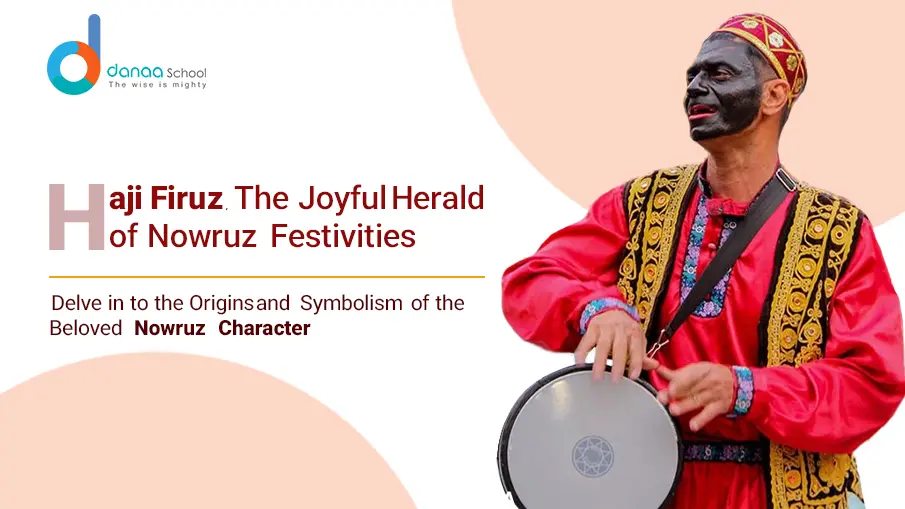Haji Firuz: Spreading Joy and Tradition
Haji Firuz is an iconic figure celebrated during Nowruz, the Persian New Year, and holds a special place in the hearts of Iranians and Nowruz communities worldwide. His joyful demeanor, vibrant red clothing, tambourine, and blackened face symbolize the arrival of spring, renewal, and rebirth.
Rooted in ancient traditions and folklore, Haji Firuz embodies joy, hope, and collective celebration, welcoming the New Year with music, laughter, and community spirit.
Who Is Baba Nowruz?
Baba Nowruz (also known as Papa Nowruz) is a legendary figure in Persian folklore who represents wisdom, renewal, and the cyclical nature of life. Often depicted as an elderly man with a long white beard, he symbolizes experience, reflection, and the passage of time.
Baba Nowruz is believed to bring prosperity, blessings, and good fortune to households during Nowruz, reminding people that every ending carries the promise of a new beginning.
The Story of Amoo Nowruz
Amoo Nowruz (Uncle Nowruz) is another beloved character associated with Nowruz celebrations. He is often portrayed as a cheerful elder who travels from house to house, bringing gifts to children and spreading happiness.
Amoo Nowruz symbolizes generosity, kindness, and goodwill—core values of the Persian New Year.
Origins of Haji Firuz
The origins of Haji Firuz trace back to ancient Persia. Some scholars associate his character with pre-Islamic traditions and Zoroastrian symbolism. His modern form became more visible during the Safavid era.
Over time, Haji Firuz evolved into a cultural icon, blending mythology, folklore, and performance into a figure synonymous with Nowruz celebrations.
The Symbolism Behind Haji Firuz
Haji Firuz’s blackened face, red clothing, and joyful music carry layered symbolism. Traditionally, the darkened face represents the passing of winter and the return from the underworld, while red symbolizes life, warmth, and renewal.
Through humor and music, Haji Firuz bridges the past and present, reminding communities that renewal follows hardship.
Cultural Significance of Haji Firuz
Haji Firuz is more than a festive entertainer; he is a cultural symbol of Nowruz. His appearance marks the official arrival of the New Year and unites people across generations and social boundaries.
From city streets to small villages, the sound of his tambourine announces celebration, joy, and shared cultural identity.
Evolution of Haji Firuz
Throughout history, Haji Firuz has adapted to social changes while preserving his core identity. Each generation reinterprets him, ensuring his continued relevance in modern society.
Despite evolving interpretations, Haji Firuz remains a cherished figure during Nowruz festivities.
Haji Firuz Traditions and Celebrations
During Nowruz, performers dressed as Haji Firuz roam streets and marketplaces, singing traditional songs and engaging audiences with humor and dance.
Children follow him joyfully, families gather, and communities share moments of collective happiness.
Differences Between Haji Firuz and Baba Nowruz
Haji Firuz represents joy, music, and movement, while Baba Nowruz symbolizes wisdom, time, and reflection. Together, they reflect the balance between celebration and contemplation within Persian culture.
Haji Firuz Around the World
Variations of Haji Firuz appear in regions celebrating Nowruz, from Central Asia to the Caucasus. While customs differ, the core themes of renewal and joy remain universal.
Controversies and Modern Interpretations
In recent decades, discussions have emerged around cultural sensitivity and representation. Some critics question elements of Haji Firuz’s portrayal, while others emphasize historical context and symbolic meaning.
Modern interpretations increasingly focus on joy, inclusivity, and cultural respect, ensuring the tradition evolves thoughtfully.
Haji Firuz in Popular Culture
Haji Firuz appears in music, literature, film, and visual arts, reinforcing his role as a living symbol of Persian heritage and celebration.
Conclusion
Haji Firuz embodies the spirit of Nowruz—joy, renewal, and community. Despite evolving interpretations, his presence continues to unite people through celebration and shared cultural memory.
By honoring tradition while embracing dialogue and inclusivity, Haji Firuz remains a meaningful symbol for future generations.
Join Danaa School to explore Iranian culture, literature, and traditions. Start your journey and learn Farsi with us.
FAQs
Is Haji Firuz only celebrated in Iran?
No. Variations of Haji Firuz appear across regions that celebrate Nowruz, including parts of Central Asia and the Caucasus.
What does Haji Firuz’s blackened face symbolize?
It traditionally represents renewal, transformation, and the transition from darkness to light.
How do people celebrate Haji Firuz?
Through street performances, music, dancing, and community gatherings during Nowruz.
Are there specific rituals linked to Haji Firuz?
Not directly, but his presence aligns with Nowruz customs such as family visits, gift-giving, and festive meals.
How has Haji Firuz evolved?
Modern portrayals increasingly emphasize cultural sensitivity while preserving joy and tradition.







